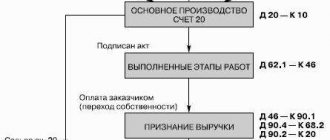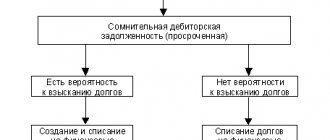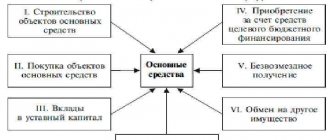VAT
This tax is considered indirect. VAT is a form of withdrawal to the state budget of part of the price of a product, service or work. It is created at all stages of the production process and is paid as it is sold. When applying VAT, the final buyer pays the seller tax on the entire price of the purchased good.
But it starts coming into the budget earlier. This is due to the fact that the amount from its part of the price added to the cost of purchased raw materials, services/work required for production is paid to the state by each participant in production at different stages. The VAT rate in the Russian Federation is 18%. It is used by default if the transaction is not classified as taxable at 10% or 0%. In the Russian Federation, VAT was introduced on January 1, 1992. The rules for its calculation and payment were first determined by the relevant Federal Law “On Value Added Tax”. Since 2001, the procedure has been regulated by Ch. 21 NK. For certain categories of payers and transactions, VAT is not established. For example, enterprises may not pay tax if the amount of their revenue for the previous three consecutive months did not exceed a certain limit (2 million rubles according to paragraph 1 of Article 145 of the Tax Code).
Why do you need an account? 19?
According to the current rules, when calculating the amount of VAT payable to the state budget for a period, the company deducts from the output tax (that is, the one included in the invoices issued to its customers), the input tax (that is, paid to suppliers when purchasing goods and services). To determine the size of the second indicator, subaccounts 19 of the accounting account are used.
When reflected on the account. 19 amounts, the accountant uses data from the invoice issued to the organization by its supplier. In this document, one line shows the “net” value of the acquired assets, the other - the amount of tax included in it. If it is not received from the counterparty, no entries are made for the specific transaction and input VAT is not deducted.
Accounts in accounting: account 20
Subaccounts 19 accounts
The article can be accessed by:
- Subaccount 19.1. It reflects VAT when purchasing OS. This takes into account the amounts of tax due or paid related to the purchase and construction of fixed assets, including individual land use facilities, etc.
- Subaccount 19.2. This article applies to VAT on purchased intangible assets.
- Subaccount 19.3. It shows VAT on purchased inventories. This article covers tax amounts assigned for payment or paid by an enterprise relating to the acquisition of materials, raw materials, semi-finished products and other types of inventories and goods.
Decor
When selling work, goods, or services, in addition to their actual cost, the buyer must pay VAT to the seller at the established rate. The latter must issue an invoice to the purchaser for its amount within five days. The calculation of the period begins from the date of shipment of products or provision of services/performance of work. In the settlement documentation and invoices of the supplier, VAT must be highlighted as a separate line. If transactions involving the sale of any services, products, or works are not subject to taxation or the seller is exempt from the obligation to pay tax, paperwork is completed without allocating it.
In this case, the payment documents must contain a corresponding entry “excluding VAT”. In the process of selling work, products or services to the public for cash, the requirements for drawing up documents and issuing invoices will be considered fulfilled if the seller has handed over a cash receipt to the buyer. He may submit other supporting paper in the prescribed form.
On the legal regulation of accounting for VAT calculations
The amount of VAT presented to the buyer by the seller is regulated by Article 168 of the 21st Chapter of the Tax Code of the Russian Federation of the same name (second part) in the latest edition.
In addition to the tariff or cost of the goods sold or services provided, the seller presents the buyer with the corresponding amount of tax, and also issues invoices within a period not exceeding five days from the date of the work performed or services provided, as well as the shipment of the goods.
The corresponding VAT amount must be highlighted as a separate line:
- in invoices;
- in primary accounting documents;
- in settlement documents, including a register of checks, as well as registers for receiving funds from a letter of credit.
In the case of the acquisition of goods, including inventory, which are not subject to tax, primary accounting documents are drawn up. In this case, invoices are issued without indicating tax amounts. Such documents are affixed with a corresponding stamp or the inscription “Without VAT”.
Tax rates for value added tax, the value of which is 10-20%, are regulated by Article 164 of Chapter 21 of the Tax Code of the Russian Federation.
It is allowed to reduce the total amount of value added tax by tax deductions indicated in Article 171 of Chapter 21 of the Tax Code of the Russian Federation.
In this case, the following three conditions must be met:
- VAT amounts were presented to/paid by the buyer when providing services/work, purchasing goods on the territory of the Russian Federation, or paid when importing goods into the customs territory of the Russian Federation.
- Tax deductions are carried out on the basis of documents indicating the actual payment of value added tax amounts, as well as invoices issued by sellers during the purchase of goods/services/work.
- In case of availability of primary registration documents after the fact of registration of goods/services/works.
If the buyer uses his own bill of exchange or one of a third party acquired in exchange for his own bill of exchange in payments for goods/services/work received, the calculation of the tax amounts that were actually paid by the drawer is made taking into account the amount paid by him on his own bill of exchange.
In case of return of goods/services/works or refusal of them, deductions of tax amounts are carried out in full, including after making the appropriate accounting adjustment within the framework of a private return, if more than one year has not passed from the date of refusal/return.
Invoice
This is a document that serves as the basis for accepting tax amounts for reimbursement or deduction. Mandatory invoice details are established in paragraph 5 of Art. 169 NK. The document must be signed by the chief accountant and director of the enterprise or other persons authorized by them. The invoice is certified by a seal. The seller must have a journal for recording these documents and a sales book. The acquirer, accordingly, must also record received invoices in the appropriate catalogue. A purchase book is also required. The procedure in accordance with which these journals are maintained is approved by government decree.
Business operations:
“Entering initial balances: reflecting the amount of VAT on work performed, services provided”
Debit 19.04 “VAT on purchased transaction type: “ VAT on purchased assets (account 19)”
“Reflection of the amount of VAT on work performed, services provided under the contract in rubles.”
Debit 19.04 “VAT on purchased services” Credit 60.01 “Settlements with suppliers and contractors”
What document is used in 1c:Accounting 2.0/1c:Accounting 3.0
: —
Receipt of goods and type of operation: “ Purchase, commission”“Reflection of the VAT amount on commission fees (accounting with the principal)”
Debit 19.04 “VAT on purchased services” Credit 60.01 “Settlements with suppliers and contractors”
What document is used in 1c:Accounting 2.0/1c:Accounting 3.0
: —
Report of the commission agent (agent) on sales
in the “Sale” menu“Reflection of the amount of VAT on agency fees (accounting with the principal)”
Debit 19.04 “VAT on purchased services” Credit 60.01 “Settlements with suppliers and contractors”
What document is used in 1c:Accounting 2.0/1c:Accounting 3.0
: —
Report of the commission agent (agent) on sales
in the “Sale” menu“Reflection of the amount of VAT on work performed, services provided under a contract in foreign currency”
Debit 19.04 “VAT on purchased services” Credit 60.21 “Settlements with suppliers and contractors (in foreign currency)”
What document is used in 1c:Accounting 2.0/1c:Accounting 3.0
: —
Receipt of goods and type of operation: “ Purchase, commission”“Reflection of the amount of VAT on work performed, services provided under the contract in cu.”
Debit 19.04 “VAT on purchased services” Credit 60.31 “Settlements with suppliers and contractors (in cu)”
What document is used in 1c:Accounting 2.0/1c:Accounting 3.0
: —
Receipt of goods and type of operation: “ Purchase, commission”“Reinstatement of VAT on work performed, services provided for export at a rate of 0%”
Debit 19.04 “VAT on purchased services” Credit 68.02 “Value added tax”
What document is used in 1c:Accounting 2.0/1c:Accounting 3.0
: —
VAT restoration
in the “Purchase — Maintaining a purchase book” menu“Attribution of VAT on work performed and services provided to export sales at a rate of 0%”
Debit 19.07 “VAT on goods sold at a rate of 0% (export)” Credit 19.04 “VAT on purchased
“Inclusion of VAT on acquired material assets in the costs of the main production, to which material assets were previously written off”
Debit 20.01 “Main production” Credit 19.04 “VAT on purchased
“Inclusion of VAT on acquired material assets in the costs of auxiliary production, to which material assets were previously written off”
Debit 23 “Auxiliary production” Credit 19.04 “VAT on purchased
“Inclusion of VAT on acquired material assets in general production expenses for which material assets were previously written off”
Debit 25 “General production expenses” Credit 19.04 “VAT on purchased
“Inclusion of VAT on acquired material assets in general business expenses for which material assets were previously written off”
Debit 26 “General business expenses” Credit 19.04 “VAT on purchased
“Inclusion of VAT on acquired material assets in the expenses of service industries and farms to which material assets were previously written off”
Debit 29 “Service production and facilities” Credit 19.04 “VAT on purchased
“Inclusion of the costs of circulation of the VAT amount on acquired material assets in organizations engaged in trading activities”
Debit 44.01 “Distribution costs in organizations engaged in trading activities” Credit 19.04 “VAT on purchased
“Inclusion of VAT on acquired material assets in distribution costs, to which material assets were previously written off in organizations engaged in trading activities”
Debit 44.01 “Distribution costs in organizations engaged in trading activities” Credit 19.04 “VAT on purchased
“Write-off of VAT on acquired material assets for business expenses in organizations engaged in industrial and other production activities”
Debit 44.02 “Business expenses in organizations engaged in industrial and other production activities” Credit 19.04 “VAT on purchased
“Inclusion of VAT on acquired material assets in business expenses for which material assets were previously written off in organizations engaged in industrial and other production activities.”
Debit 44.02 “Business expenses in organizations engaged in industrial and other production activities” Credit 19.04 “VAT on purchased
“VAT deduction for work performed, services provided”
Debit 68.02 “Value added tax” Credit 19.04 “VAT on purchased
“Deduction of VAT on work performed, services provided, when maintaining simplified VAT accounting”
Debit 68.02 “Value added tax” Credit 19.04 “VAT on purchased
“Write off the amount of VAT on work performed, services provided if, in accordance with current legislation, VAT amounts are not subject to reimbursement”
Debit 91.02 “Other expenses” Credit 19.04 “VAT on purchased
“Write-off of VAT on acquired material assets for other expenses not related to core activities”
Debit 91.02 “Other expenses” Credit 19.04 “VAT on purchased
“Inclusion of VAT on acquired material assets in other expenses not related to the main activities for which material assets were previously written off”
Account 19: postings
After accepting the purchased goods, the buyer pays VAT to account 19. In accounting, this item also includes tax amounts paid on business trip expenses. The calculation is carried out at a rate of 16.67% of the specified expenses (excluding sales tax). For the amount entered into account 19, the buyer, in accordance with the information from the invoices issued by the sellers, as well as documents confirming the payment of tax, has the right to reduce the mandatory deduction to the budget. This opportunity is available to those acquirers who use the received values for production purposes. In this case, it is necessary to make an entry: “Db 68 CD 19.”
What is account 19 used for in accounting?
In accordance with the Tax Code of the Russian Federation, business entities in the general regime must include VAT in the cost of products produced, services provided and work performed. It is called output tax.
On the other hand, a business entity is a consumer of products, works and services, in the cost of which their suppliers also included these amounts of mandatory collection. This tax is called input VAT.
Input VAT is subject to exclusion from the cost of purchased material assets, works and services. An organization or individual entrepreneur has the right, when paying its outgoing VAT to the budget, to offset the incoming VAT on received goods, works, and services.
Therefore, incoming VAT is subject to separate reflection in accordance with the Chart of Accounts on account 19. The information collected on this account is of great importance in determining the VAT payable, therefore the indicators reflected on the account are under close attention when carrying out tax audits.
The amounts reflected in account 19 must be included in the tax register, which is called the purchase book. Information is entered into it based on invoices received from suppliers.
This account is also used by entities under the simplified tax system. This is due to the fact that they can also purchase goods, works, and services, the price of which includes input VAT. Since these entities cannot offset the output VAT due to its absence, the accumulated amounts are written off as a separate item in the company’s expenses.
Attention! Business entities in special regimes have the right not to use account 19. However, it must be remembered that there is a possibility for them of violating the conditions for using the special regime and losing the right to use it.
After such an event, it is necessary to recalculate all taxes, including VAT. Failure to use account 19 in such a situation will lead to the re-posting of all received documents with the allocation of tax.
When determining what is reflected in the debit and credit of this account, you need to remember that VAT may be reflected here on advance amounts listed to suppliers.
If an organization or individual entrepreneur simultaneously applies several taxation systems, for example OSNO and UTII, then it must organize separate accounting of VAT amounts on purchased goods, works and services that belong to different regimes on account 19.
Attention! Thus, activities that fall under VAT and without VAT can be carried out at the same time. Tax on non-taxable transactions cannot be claimed as a deduction, but must be included in the cost of the acquired assets.
Inclusion of VAT in buyer's expenses
The tax amounts that are presented to the purchaser are included in his costs when using products, works, services:
- In the manufacture/sale of objects, operations for the sale of which are not subject to taxation (exempt) under paragraphs 1-3 of Art. 149 NK.
- The production/transfer of products, services, works, operations for which for one’s own needs are considered subject to taxation under Ch. 21, but are not subject to tax accounting under paragraphs 2, 3 of Art. 149 NK.
- Sales outside the territory of the Russian Federation.
For the VAT amounts presented to the buyer, the following entry is made: “Db 20 (44, 23, 26, 25, etc.) Kd 19.”
General rules
Count 19 should be maintained while observing a number of requirements:
- The debit reflects the amounts that are payable to contractors and suppliers for acquired material assets, as well as accepted services/work.
- The item balance should not contain VAT charged to counterparties.
- The paid amounts are presented to the budget in accordance with the rules established in the Tax Code.
- VAT allocated to contractors/suppliers, but not presented to the budget according to the Tax Code, must be reflected in the accounts of valuables, costs or other expenses.
VAT payers
The circle of persons paying VAT is quite wide. These include organizations, individual entrepreneurs on the general taxation system, and entities involved in the import of goods into the territory of the Russian Federation.
| ★ Best-selling book “Accounting from scratch” for dummies (understand how to do accounting in 72 hours) > 8,000 books purchased |
In addition to these persons, other entities are also recognized as tax payers:
- Representatives of foreign companies, if they operate within the Russian Federation.
- Non-profit organizations, budgetary, trade union institutions, if implementation occurs in the process of their activities.
- Authorities and local self-government.
- Tax agents, that is, persons purchasing goods from foreign entities, receiving municipal property for rent and other entities acting in accordance with the adopted provisions of Article 161 of the Tax Code of the Russian Federation. The obligation to accrue and further pay tax arises even in situations where they themselves are not recognized as VAT payers.
However, not all organizations and individual entrepreneurs must have the status of tax payers. These do not include the following categories of legal entities. and physical persons:
- applying preferential tax regimes, such as UTII, simplified tax system, unified agricultural tax, patent system;
- engaged in the sale of goods exempt from VAT (this list includes medical goods, social services, as well as in the field of education, medicine, culture, sales of coins made of precious metals, sales of religious products, banking operations and others);
- entities that have received exemption from VAT payer status if the total sales amount for the previous 3 months is less than 2,000,000 rubles;
- participants of the Skolkovo project.
The exception is the import of goods into the customs territory of the Russian Federation. In such cases, VAT is paid by all persons, regardless of their status and the applicable tax regime.
Important point
According to a number of experts, in DB account 19 the accrued VAT should be included in the budget for adopted fixed assets, completed capital construction, and implemented in an economic way. But other authors recognize this proposal as unfounded. Account 19 reflects the amounts of VAT that must be paid to contractors and suppliers, that is, legal entities (organizations). When an enterprise has budgetary tax obligations, it is necessary to take into account the circumstances under which they arose. In the process of construction, a taxable object is created using an economic method. In the absence of the possibility of presenting this tax to the budget, the accrued VAT amounts would have to increase the initial cost of the fixed assets. But according to tax legislation, enterprises show tax. It follows from this that these VAT amounts represent a certain amount of budget obligations to the payer. The latter, if the requirements are met, will present them to the budget subsequently. Thus, these amounts should be reflected in settlement accounts, in particular in accounts. 76.
Example
Let's consider a situation where, throughout March 2014, an enterprise bought certain products from a supplier and subsequently resold them to its own customers. The batch of goods was purchased and sold in full. Purchase costs - 12 thousand rubles. Of this amount, 1830.51 is VAT. The amount of tax was separated from the cost of production and charged to account 19. This operation is reflected in two entries:
- Db 41 Kd 60 – the cost of purchased products is taken into account: 10,169.49 rubles.
- Db 19 Kd 60 – shows the input VAT on the purchase of goods RUB 1,830.51.
At the end of the reporting year, the company writes off the VAT amount to the account. 68. Thus, the organization uses its right to reduce debt to the budget. The following entry is made: “Db 68 Kd 19 – the amount to reduce the amount of accrued tax of 1830.51 rubles is transferred to the debit of the account for settlements with the budget.”
In the same March, the company sells products to its own customers at a cost 1.5 times higher than the purchase price (18 thousand rubles). This operation is reflected by the entries:
- Db 90.2 Kd 41 – the cost of goods sold is shown as RUR 10,169.49.
- Db 62 Kd 90.1 – accounting for the buyer’s debt to the enterprise 18 thousand rubles. (with VAT 2745.76 rubles).
- Db 90.3 Kd 68 - the amount of VAT allocated for deduction to the budget is 2745.76 rubles.
Next, the financial result of the transaction is determined by establishing the difference between the turnover in the debit and credit of the “Sales” account: 10,169.49 rubles. + 2745.76 rub. — 18,000 rub. = - 5,084.75 rub.
Minus here means profit. The received amount is transferred to the account. 99: Db 90.9 Kd 99 – income from March sales 2014 5,084.75 rub.
As a result, on the account. 68, the amount of VAT to be transferred to the budget is formed. It is defined as the difference between Kd and Db: 2,745.76 rubles. — 1,830.51 rub. = 915.25 rub. – tax for deduction to the budget generated from March sales in 2014.
Invoice 19 VAT on purchased assets
We confirmed the 0% rate on three documents. At the end of the quarter the account balance is now 19.07. Tell me, is this correct? Shouldn't the account be closed? There is also an additional question. Documents have been submitted for additional receipt. services, for services that can be attributed to foreign economic activity. All additional documents are included in the purchase book. services - and for goods for which the 0% rate is confirmed and for which it is not confirmed. Is this section of accounting not implemented in the BP or are we doing something wrong? Thanks in advance for your answers :-)
Try the new free service for quick code analysis of typical configurations 1c-api.com
ATTENTION!
If you have lost the message input window, press
Ctrl-F5
or
Ctrl-R
or the Refresh button in your browser.
The topic has not been updated for a long time and has been marked as archived. Adding messages is not possible.
But you can create a new thread and they will definitely answer you!
Every hour there are more than 2000
people on the Magic Forum.
| Nasya | |
| Naumov | there should be no remainder. |
| Naumov | There is an article on implementing VAT accounting on ITS. read it. |
| Nasya | I read an article on ITS... The article and many other places describe a situation where VAT is first accepted for deduction at a rate of 18%, then in the next quarter it is sold, VAT is restored, and so on according to the scheme. And in the first quarter we bought goods for sale, and in the same quarter we sold them for export (by the way, we have a sales agreement in rubles and there is no way to check the “sale for export” checkbox). So, in the same first quarter, we confirmed the 0% rate on three out of five documents. We did everything using the VAT Accounting Assistant. And we received the account balance on July 19... |
| Sandy_S | (0) look at what balances are on what invoice balances, and the distribution of VAT on services for export is made into a document on the distribution of indirect VAT, although so that it relates purely to exports, I picked this document apart. |
| Nasya | (4) You rewrote the document Distribution of VAT on indirect expenses so that it could distribute VAT on certain services only to activities with 0% VAT, did I understand correctly? |
| Sandy_S | Yes, and also under a specific contract (agreement) and was not distributed to the domestic market. |
| Nasya | (6) and you are using the document Additional Receipt. expenses? |
| Sandy_S | (7) no we come to vocational school services |
| Sandy_S | if additional the services are no longer indirect, they fall on a certain party, although I won’t lie, I didn’t experiment |










